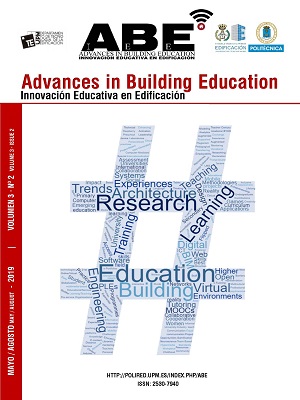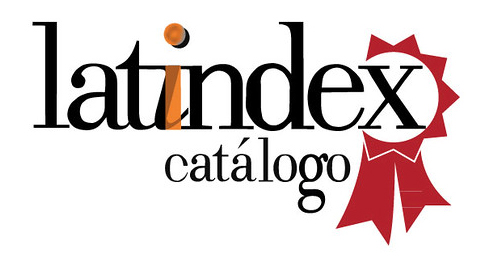Interactive lecture notes for structural dynamic analysis in frequency domain = Apuntes de clase interactivos para el análisis de la dinámica estructural en el dominio de la frecuencia
DOI:
https://doi.org/10.20868/abe.2019.2.3988Keywords:
Learning based on experiments, Active learning technologies, Interactive lecture notes, Dynamic analysis of structures, Fourier analysis, Aprendizaje basado en experimentos, Tecnologías activas de aprendizaje, Material docente interactivo, Análisis dinámico de estructuras, Análisis de FourierAbstract
Abstract
Dynamic and experimental analysis of structures are two of the most abstract and complex disciplines in structural engineering, because of its awkward mathematical and physical background and due to the multidisciplinary knowledge needed to go over the whole analysis (from the acquisition of measures up to the final interpretation of results). In particular, Fourier analysis (frequency domain analysis) in discrete time, which is routinely used in the dynamic analysis, is not usually well-understood and even is not well computed in discrete time. Frequently, students lose motivation trying to decrypt difficult mathematical developments, which do not let them to interpret properly complex concepts which are extremely important for current analysis in discrete time such as: Fourier transforms, aliasing, leakage, filtering, windowing, etc. For this reason, the authors has implemented a new teaching tools based on the numerical experiments and interactive learning that transform the learning experience into a more pleasant process than in the pass. In this way, recently-developed tools as “MATLAB Live Editor” allows professors to create interactive lecture notes, which students can easily follow, modify and simultaneously run during classes, developing its own intuitive interpretation of the knowledge. This tool is been successfully employing to teach dynamic analysis of structures in frequency domain with excellent feedback from the students.
Resumen
El análisis experimental y dinámico de estructuras son dos de las disciplinas más complejas y abstractas de la ingeniería estructural debido a la complejidad de los fundamentos que se manejan y al conocimiento multidisciplinar necesario para llevar a cabo el proceso completo de análisis (desde la toma de datos hasta la interpretación final de los resultados). En particular, el análisis de Fourier (análisis en el dominio de la frecuencia), el cual se usa continuamente en el análisis dinámico, no siempre se entiende adecuadamente e incluso no se aplica correctamente en el dominio discreto. Con frecuencia los estudiantes pierden la motivación intentando comprender los desarrollos matemáticos asociados, lo que no les permite interpretar adecuadamente conceptos más complejos y a la vez importantes como: la transformada de Fourier, “aliasing”, “leakage”, filtrado, ventanas de ponderación, etc. Por ello, los autores han implementado una nueva herramienta basada en la experimentación numérica y en el aprendizaje interactivo, haciendo del mismo un proceso más llevadero que en el pasado. Así, herramientas recientes como “MATLAB live Editor” permiten que los profesores creen clases interactivas que los estudiantes pueden de forma sencilla, seguir, modificar y ejecutar durante las clases, desarrollando un conocimiento más intuitivo del problema. Los autores están empleando esta herramienta exitosamente en el análisis dinámico de estructuras en el dominio de la frecuencia con muy buenos comentarios por parte de los estudiantes.
Downloads
References
Ewins, D. J. (2000). Modal Testing: theory, practice and application. (ed) Research Studies Press LTD. Second edition. pp: 215-218
Mc Mahon, D. (2007). Signals and systems demystified – A self-teaching guide. (ed) Mc Graw Hill. First edition. pp: 146-171
Barroso, L. R., Morgan, J. R. J. (2012). Developing a dynamic and vibration course for civil engineering students based on fundamental principles. Advances in Engineering Education, vol. Winter. pp:1-35
Sanderson, G. (2018). But what is the Fourier transform? A visual introduction.
“https://www.youtube.com/watch?v=spUNpyF58BY”. You Tube.
Ortiz-Echevarri, C. J., Rodríguez-Reséndiz, J., Garduño-Aparicio, M. (2018). An approach to STFT and CWT learning through music hands-on labs. Computer Applications in Engineering Education. (ed) Wiley, vol. 26, pp. 2026-2035.
Wu, Y., De Vries, C., Dunsworth, Q. (2018). Using LEGO Kits to teach higher level problems solving skills in systems dynamics: a case study. Advances in Engineering Education, vol. spring, pp. 1-20.
Seĉkář, P., Svoboda, D. (2016). FTutor: An interactive guide to the fundamentals of frequency analysis. Computer Applications in Engineering Education. (ed) Wiley, vol. 25 (3), pp. 508-520.
Cobos, M., Roger, S. (2018). SART3D: A MATLAB toolbox for spatial audio and signal processing education. Computer Applications in Engineering Education. (ed) Wiley, vol. 27, pp. 971-985.
Berber, S. M., Sowerby, K. W. (2017). Visual presentation of abstract theoretical concepts using animations in communication system courses. Computer Applications in Engineering Education. (ed) Wiley, pp. 1-13.
Dezure, D. (2001). Research on student notetaking: Implications for faculty and graduate student instructors. CRLT Occasional Papers, Center for Research on Learning and Teaching, University of Michigan, No. 16.
MathWorks. (2019). MATLAB Live Editor. “https://es.mathworks.com/products/matlab/live-editor.html”. The Mathworks. Inc.
Colombini, J. (2018). Worker retention, response quality and diversity in microtaskcrowdsourcing, an experimental investigation of the potential for priming effects to promote project goals. (ed) The University of Vermont, Scholar Works.
Hattie, J., Yates, G. (2014). Visible learning and the science of How we learn. (ed) Routledge, New York, NY.
Díaz I. M., et al. A mobile tool for teaching advanced dynamic analysis. Advances in Building Education, vol. 3 (1), pp. 72-82,
García-Palacios, J. H., Díaz, I. M., et al. (2018). Learning dynamic analysis of structures using handy and affordable equipment. On the way of smart structures. IV International Conference on Structural Engineering Education, Madrid.
Downloads
Published
Issue
Section
License
ABE (Advances in Building Education / Innovación Educativa en Edificación) does not charge authors for processing or publishing an article and provides immediate Open Access to its content. All content is available free of charge to the user or his institution. Users are permitted to read, download, copy, distribute, print, search or link to the full text of articles, or use them for any other lawful purpose, without prior permission from the publisher or author. This is in accordance with the BOAI definition of open access.
- Authors retain the copyright and grant to the journal the right to a Creative Commons attribution / Non-Commercial / Non-Derivative 4.0 International (CC BY NC ND) License that allows others to share the work with an acknowledgement of authorship and non-commercial use.
- Authors may separately establish additional agreements for the non-exclusive distribution of the version of the work published in the journal (for example, placing it in an institutional repository or publishing it in a book).
Unless otherwise indicated, all contents of the electronic edition are distributed under a Creative Commons license.














